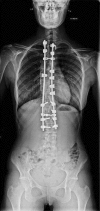Use of the Universal Clamp in adolescent idiopathic scoliosis for deformity correction and as an adjunct to fusion: 2-year follow-up
- PMID: 22852033
- PMCID: PMC3234888
- DOI: 10.1007/s11832-011-0357-z
Use of the Universal Clamp in adolescent idiopathic scoliosis for deformity correction and as an adjunct to fusion: 2-year follow-up
Abstract
Purpose: Among posterior surgical techniques for treating adolescent idiopathic scoliosis (AIS), hybrid constructs with pedicle-screw fixation in the lumbar spine and other anchors in the thoracic spine have been reported to provide to be of more physiological value in postoperative thoracic kyphosis than all-screw constructs. The Universial Clamp (UC) equipped with a soft sublaminar band is a relatively new thoracic anchor that can be used in hybrid constructs. A dedicated reduction tool that applies traction to the sublaminar band permits gentle translation of the thoracic curve to the precontoured fusion rods, which have been previously anchored distally by pedicle screws and proximally by hooks in a claw configuration. The aim of this study was to evaluate radiographic results of AIS treatment using UC hybrid constructs.
Methods: This was a prospective case series in which 29 consecutive patients with Lenke type 1, 2 or 3 AIS operated on by two surgeons in two centers were followed for 24 months. Necessity for anterior release was an exclusion criterion.
Results: A total of 5.4 ± 1.4 UCs were used per patient. The major thoracic curve was reduced from 55 ± 7° to 14 ± 6° at 1 month and 17 ± 6° at 24 months (correction 70%) without complications. In the patients who had less than 20° of T5-T12 kyphosis preoperatively, thoracic kyphosis improved from 14 ± 4° to 20 ± 3° at 3 months and 24 ± 9° at 24 months. In the other patients, preoperative thoracic kyphosis (27° ± 6°) was unchanged by the operation.
Conclusion: UC hybrid constructs appear to safely provide satisfying coronal correction while consistently improving thoracic kyphosis in patients who also have preoperative hypokyphosis. We hypothesize that diminution in thoracic kyphosis was consistently avoided due to the straightforward traction of the spine to the fusion rods into which the chosen kyphosis was contoured by the surgeon before applying the reduction tool to the sublaminar bands.
Keywords: Adolescent idiopathic scoliosis; Rod precontouring; Thoracic kyphosis; Universal Clamp.
Figures








Similar articles
-
Use of the Universal Clamp in adolescent idiopathic scoliosis.Eur Spine J. 2014 Jul;23 Suppl 4:S446-51. doi: 10.1007/s00586-014-3341-8. Epub 2014 May 15. Eur Spine J. 2014. PMID: 24828958 Review.
-
Efficacy and safety of posteromedial translation for correction of thoracic curves in adolescent idiopathic scoliosis using a new connection to the spine: the Universal Clamp.Eur Spine J. 2009 Feb;18(2):158-69. doi: 10.1007/s00586-008-0839-y. Epub 2008 Dec 16. Eur Spine J. 2009. PMID: 19089466 Free PMC article. Clinical Trial.
-
Deformity correction in thoracic adolescent idiopathic scoliosis.Bone Joint J. 2020 Mar;102-B(3):376-382. doi: 10.1302/0301-620X.102B3.BJJ-2019-0993.R1. Bone Joint J. 2020. PMID: 32114809
-
Hybrid constructs for tridimensional correction of the thoracic spine in adolescent idiopathic scoliosis: a comparative analysis of universal clamps versus hooks.Spine (Phila Pa 1976). 2010 Feb 1;35(3):306-14. doi: 10.1097/BRS.0b013e3181b7c7c4. Spine (Phila Pa 1976). 2010. PMID: 20075778
-
Posterior Surgery for Adolescent Idiopathic Scoliosis With Pedicle Screws and Ultrahigh-Molecular Weight Polyethylene Tape: Achieving the Ideal Thoracic Kyphosis.Clin Spine Surg. 2016 Oct;29(8):E376-83. doi: 10.1097/BSD.0b013e31826eaf09. Clin Spine Surg. 2016. PMID: 22907066
Cited by
-
Adolescent idiopathic scoliosis treated with posteromedial translation: radiologic evaluation with a 3D low-dose system.Eur Spine J. 2013 Nov;22(11):2382-91. doi: 10.1007/s00586-013-2776-7. Epub 2013 Apr 12. Eur Spine J. 2013. PMID: 23580058 Free PMC article.
-
Role of thoracoscopy for the sagittal correction of hypokyphotic adolescent idiopathic scoliosis patients.Eur Spine J. 2014 Dec;23(12):2635-42. doi: 10.1007/s00586-014-3566-6. Epub 2014 Sep 11. Eur Spine J. 2014. PMID: 25208500
-
The Universal Clamp hybrid system: a safe technique to correct deformity and restore kyphosis in adolescent idiopathic scoliosis.Eur Spine J. 2013 Nov;22 Suppl 6(Suppl 6):S823-8. doi: 10.1007/s00586-013-3014-z. Epub 2013 Sep 20. Eur Spine J. 2013. PMID: 24052403 Free PMC article.
-
Use of the Universal Clamp in adolescent idiopathic scoliosis.Eur Spine J. 2014 Jul;23 Suppl 4:S446-51. doi: 10.1007/s00586-014-3341-8. Epub 2014 May 15. Eur Spine J. 2014. PMID: 24828958 Review.
-
Could CCI or FBCI Fully Eliminate the Impact of Curve Flexibility When Evaluating the Surgery Outcome for Thoracic Curve Idiopathic Scoliosis Patient? A Retrospective Study.PLoS One. 2015 May 18;10(5):e0126380. doi: 10.1371/journal.pone.0126380. eCollection 2015. PLoS One. 2015. PMID: 25984945 Free PMC article.
References
-
- Daffner SD, Beimesch CF, Wang JC (2010) Geographic and demographic variability of cost and surgical treatment of idiopathic scoliosis. Spine (Phila Pa 1976) 35:1165–1169 - PubMed
-
- Hicks JM, Singla A, Shen FH, Arlet V (2010) Complications of pedicle screw fixation in scoliosis surgery: a systematic review. Spine (Phila Pa 1976) 35:E465–E470 - PubMed
-
- Vora V, Crawford A, Babekhir N, Boachie-Adjei O, Lenke L, Peskin M, Charles G, Kim Y. A pedicle screw construct gives an enhanced posterior correction of adolescent idiopathic scoliosis when compared with other constructs: myth or reality. Spine. 2007;32:1869–1874. doi: 10.1097/BRS.0b013e318108b912. - DOI - PubMed
LinkOut - more resources
Full Text Sources

